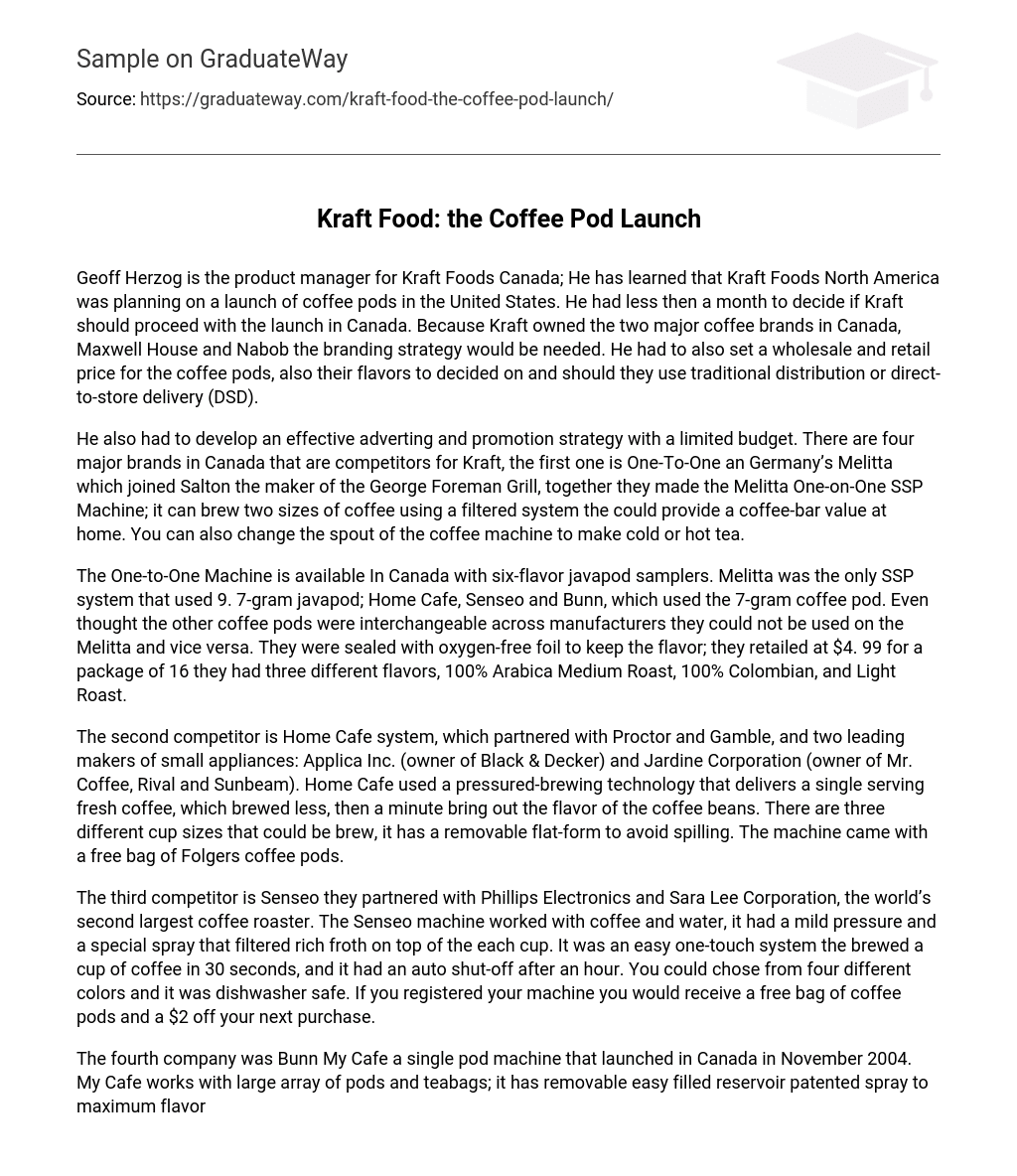Geoff Herzog, the product manager for Kraft Foods Canada, discovered that Kraft Foods North America had intentions to introduce coffee pods in the United States. As a result, he was given less than a month to determine whether Kraft should also release them in Canada. It was crucial to establish a branding strategy considering Kraft’s ownership of the two primary coffee brands in Canada, Maxwell House and Nabob. Additionally, he had to establish wholesale and retail prices for the coffee pods, finalize flavor options, and decide between traditional distribution or direct-to-store delivery (DSD).
He had to develop an advertising and promotion strategy with a limited budget. In Canada, there are four major brands that compete with Kraft. One of these is One-To-One, a brand that belongs to Germany’s Melitta. Melitta joined forces with Salton, the maker of the George Foreman Grill, to create the Melitta One-on-One SSP Machine. This coffee machine can brew two different sizes of coffee using a filtered system. It aims to provide a coffee-bar experience at home. Additionally, the spout of the coffee machine can be changed to make cold or hot tea.
The One-to-One Machine is available in Canada and offers six-flavor javapod samplers. Melitta was the only SSP system that utilized a 9.7-gram javapod, while Home Cafe, Senseo, and Bunn utilized a 7-gram coffee pod. Although the other coffee pods were interchangeable among manufacturers, they could not be used with the Melitta and vice versa. These coffee pods were sealed with oxygen-free foil to maintain flavor. They were sold for $4.99 per package of 16 and included three different flavors: 100% Arabica Medium Roast, 100% Colombian, and Light Roast.
The second competitor is the Home Cafe system, which formed a partnership with Proctor and Gamble, as well as two leading manufacturers of small appliances: Applica Inc. (the owner of Black & Decker) and Jardine Corporation (the owner of Mr. Coffee, Rival, and Sunbeam). Home Cafe utilized a pressured-brewing technology that allows for the creation of a fresh, single serving of coffee in less than a minute, while bringing out the full flavor of the coffee beans. It offers three different cup sizes and features a removable flat-form to prevent any spills. Additionally, each machine includes a complimentary bag of Folgers coffee pods.
The third contender in the market is Senseo, which formed a partnership with Phillips Electronics and Sara Lee Corporation, the second largest coffee roaster globally. The Senseo machine operated by utilizing coffee and water, employing mild pressure and a specialized spray to create a creamy froth atop each cup. Additionally, it boasted an effortless one-touch system that brewed a cup of coffee within just 30 seconds. Furthermore, it included an automatic shut-off feature after one hour and was available in four vibrant color options. Notably, this machine could be conveniently cleaned in a dishwasher. As an added benefit, customers who registered their device were rewarded with a complimentary bag of coffee pods along with a $2 discount for their subsequent purchase.
Bunn My Cafe was the fourth company to introduce a single pod machine in Canada in November 2004. This machine is compatible with various pods and teabags and includes features such as an easy-to-fill removable reservoir, a patented flavor-extracting spray, and a quick 30-second brewing time. It also offers nine options for adjusting coffee strength and its components are dishwasher safe. The target market for this product in Canada consists of educated coffee enthusiasts aged between 25 and 54 years old, with an average household income of $91,000. Approximately 88 percent of the married individuals living in urban areas make up around three quarters of the target market.
The focus group research among SSP machine owners in population-rich provinces such as Ontario, Quebec, British Columbia, and Alberta revealed that they appreciate being able to use different coffee brands with their brewers. Kraft had expectations that the SSP machine would gain acceptance in 12.5 million households in Canada, reaching a six percent market share by the end of 2004 and eight percent by 2006. On average, SSP machine owners consume between seven to fourteen coffee pods per week. In order to achieve their goal, Kraft needs to capture at least 35 percent of the coffee pod segment and hold a market share of 45 percent by the end of 2006.





